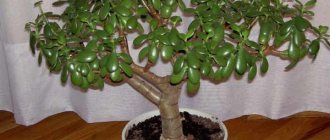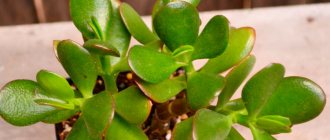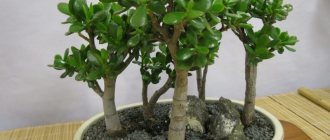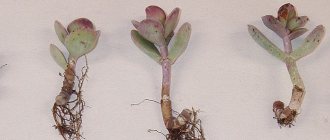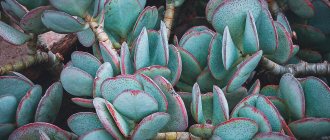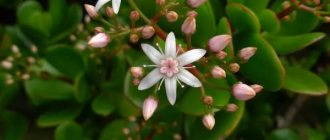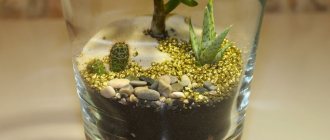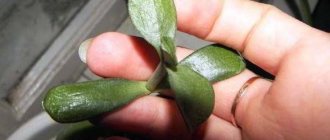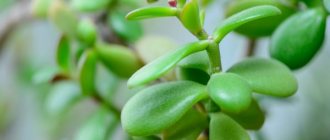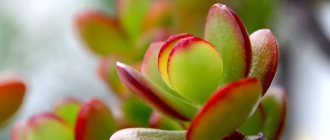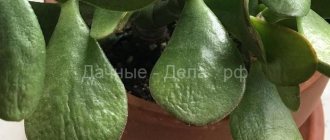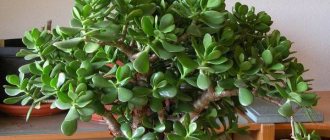Crassula flower: features of the genus of succulent culture
Crassula is a large genus of succulent plants found in many parts of the world, but the species used in horticulture or by collectors mostly originate in South Africa. The genus Crassula has an average of 300-500 species.
Photos of different types of Crassula
The external diversity of Crassulas is very great. Such succulents are found in the form of herbaceous or aquatic plants, they can be tree-like shrubs, miniature succulents. A common feature of most representatives of the genus is the placement of leaf blades on the shoot opposite each other. At home, Crassula are smaller in size than those that grow in nature. But over time, the crop becomes a miniature or medium-sized tree, which has a fairly thick stem.
The leaves have a simple, entire-edged shape; some species have ciliated leaf blades. Inflorescences can be lateral or terminal, the configuration is racemose or umbellate-paniculate. Flowers can consist of several shades - yellow, red, white, pale blue. But keep in mind the fact that indoor Crassula almost never blooms.
But their unpretentiousness, ease of care, and spectacular appearance have made these types of plants one of the most popular in decorating rooms.
Varieties
var. atropurpuria
The type variety is the most common and varied in appearance. Key features to identify it:
- The leaf surface is smooth or papillary, but never pubescent.
- Along the stem of the inflorescence there are 3-4 (less often 2-5) pairs of sterile bracts.
- Pointed tubular (furrowed) petals are papillary.
In addition, the stems of this variety are usually erect branches (woody at the base, new hairy shoots). New leaves are erect, spread out and fall off over time. The leaf shape is usually oblong to oblong (no more than 6 cm long), flattened with a convex outer/bottom surface. They are wedge-shaped at the base and blunt at the apex. Around the Langeberg and Swartberg mountains, west to Worcester, some forms may have thin, pointed leaves.
This variety occurs from Worcester and Swellendam in the west, east to Port Elizabeth, and also around Mount Swartberg. Habitat is typically dry, rocky slopes and outcrops.[2]
- S. atropurpurea
var.
atropurpuria
inflorescence showing many pairs of sterile bracts - S. atropurpurea
var.
atropurpuria
with smooth leaves and 3-4 pairs of bracts along the stems. - S. atropurpurea
var.
atropurpuria - S. atropurpurea
var.
atropurpuria
showing its more or less erect branches. - S. atropurpurea
var.
atropurpuria
var. anomaly (Schonl. & Bak. F.) Toelken.
S. atropurpurea
var
anomala
has reddish edges around the pubescent leaves. It has thick, succulent, cascading stems and erect hairs.
A distinctive southwestern variety. Key diagnostic features include:
- The leaves and stem are covered with erect hairs.
- Along the stem of the inflorescence there is 1 (less often two) pair of sterile bracts.
- The petals have very prominent dorsal appendages (canalicular on the inside).
- The stems are somewhat pressed to erect branches, fleshy and relatively thick (4-8 mm).
Additionally, the leaves are green to yellow-green in color (turning reddish when dry or in direct sun). The leaf shape is almost always obovate or rounded, with blunt apices.
This variety comes from Table Mountain in the west, to Montagu in the east and north to the Bokkeveld mountains. This is very common in Robertson Karoo. Its habitat is usually more sheltered rocky ledges on southern slopes. Together with var. muirii ("rubella")
, but
the anomaly
has significantly thicker stems, as well as leaves and stems with erect hairs.[3][4]
var. Muirii (Schönland) R. Fern. (formerly rubella (Compton) Token)
C. atropurpurea
var.
Muirii
(formerly
"rubella"
) is similar to var.
anomalous
, but has thinner, straighter stems and blunt, appressed hairs.
Another southwestern variety. Key diagnostic features include:
- The leaves and stem are covered with blunt/adpressed/upcurved hairs (hairy).
- Along the stem of the inflorescence there are 1-2 (less often 3) pairs of sterile bracts.
In addition, the stems have erect branches, sinewy and thin (2-4 mm). The leaves are gray-green to reddish-brown in color. Under natural conditions, they have a bright reddish tint along the edge of the leaf, where the hairs are slightly longer (though not in a single row). The leaf shape is obovate, with blunt apices.
This Karoo variety comes from Worcester, east to Prince Albert and north to Cedarburg. Its habitat is usually exposed in shallow waters on dry, sunny rocky peaks.[5]
var. cultiform (Fridr.) Token.
From quartzite gravel on slopes and dunes in the far north, near Garis.[6]
var. Purcellii (Shonl.) Token.
From the Karoo sandstone/quartzite slopes, from the Anysberg and north of the Witteberge Mountains, to the western Cedarberg Mountains.[7]
var. Watermeyeri (Compton) Token.
From the arid sheltered rocky crevices through Namaqualand.[8]
Crassula or Crassula flower: care at home
Crassulas prefer a minimum of watering, regular washing of leaf plates and systematic feeding. Proper planting of crops is also of great importance. Pots that are too large will cause the root of the bush to begin to grow deeper and the trunk to develop upward. This will lead to weakening and thinning of the plant. Therefore, choose small and low pots.
Photo of Crassula marnieriana
Start preparing the correct soil mixture. It is formed on the basis of turf, leaf soil, as well as humus. Additionally add sand and brick chips. After the bush reaches 15 centimeters in height, pinch off 2 small leaf plates that are located at the top. At this point, the bush will begin to produce good branching - instead of 1 pair of leaves, two will form. The upper leaves are systematically broken off where branching is expected. This will give the Crassula the required shape.
Let us dwell on the main points that should be observed when caring for such beauties:
Lighting
The Crassula succulent tolerates sunlight well, so representatives of this kind can be safely placed on south-facing windows. But the optimal solution would still be to place the flowers on southwestern or eastern windows. If there is a lack of lighting, the leaves of crops will lose their decorative effect.
Ambient temperature
Crassulas are heat-loving plants. Therefore, summer is considered ideal and comfortable for the existence of succulents. But in winter it will be quite good even at temperatures of +10+15 degrees. These crops do not depend on air humidity; they grow equally, whether at low or high humidity.
Watering
The best option for watering Crassula is to use water as needed. When the top layer of soil dries, it means you can moisten the soil. In winter, you should wait until the substrate dries completely. The drying depth of the soil is 20-30 mm. It is not recommended to allow water to stagnate; it is better to let the substrate dry out.
Fertilizers
Crassulas prefer spring and summer feeding. They are usually performed once a month. The best option for such purposes would be fertilizer for cacti or succulents. In the fall and winter, you should stop applying all fertilizers.
Pruning and shaping Crassula
It is recommended to create a beautiful tree shape from a young age. Adult representatives may have stumps left in the places where pruning was done. This negatively affects the decorative appearance of crops.
Crassula transplant
It is recommended to replant succulents after the root system does not have enough space in the pot. This process is usually carried out once every 2-3 years. The optimal period is spring.
Crassula flower before planting in a new pot
Choose a new container larger than the old one, and be sure to form a drainage layer at the bottom. Expanded clay or crushed shards are perfect for this. After this, the flower is transplanted into a new pot, using the transshipment method. If the root system grows strongly in length, shorten the roots a little. Wanting the succulents to remain miniature, the Crassula indoor plant is not replanted at all.
What are the methods of propagation of Crassula?
There are several options for propagating succulent crops of the Crasula genus. Let's look at the main methods.
Reproduction of Crassula by seeds
Crassula seeds are sown in wide bowls. They are filled with a soil substrate based on sheet soil and sand (1 to 2). The top of the container is covered with glass, and condensation is removed daily. Crops are also regularly ventilated. You can observe the appearance of the first shoots after 2 weeks. When the seedlings grow up, they are planted in a large container, with a distance of 10 millimeters between the bushes. The container is filled with a sand-turf mixture. When the picking is completed, the container with succulents is placed in a room with good lighting. When they grow up, each bush is placed in a separate pot. The air temperature at first should be +16-18 degrees Celsius.
Reproduction by cuttings
Cuttings allow you to get new Crassulas much faster than using the seed method. Castings and sections of stems are used as cuttings. A large leaf plate or shoot is trimmed using a sharp knife.
Photos of Crassula cuttings
The cut areas are treated with charcoal crumbs. The cuttings are withered for 2-3 days, after which they are planted in a substrate based on sand or leaf soil. After the roots appear, each cutting is planted in an individual container. For cultivation you will need leaf and turf soil, as well as sand (ratio - 1 to 1 to 1). After this, the bushes can be placed in a permanent location, and care is provided in the same way as for adult representatives.
Crassula flower: pests and diseases
The biggest problem for Crassulas will be stagnation of water in the soil. This can cause root rot. Succulents can also suffer from drafts; in this case, the trees may dry out and the leaves may fall off.
Among the pests, the most popular are mealybugs. To eliminate them, you will need a cotton wool that is well moistened in an alcohol solution. Scale insects are also sometimes found. To combat them, treatment with Actellik is suitable. Fitoverm helps best against spider mites.
Diseases and pests
- The main diseases of the Crassula are associated with defects in care:
- Root rotting: occurs from excess fertilizers and maintenance at low temperatures; the plant is transplanted into a new substrate or placed in a warm room;
- wilting and wrinkling of leaves: occurs with excess moisture; reduce watering, replant if necessary;
- stretching of shoots and shedding of leaves: from lack of lighting; placed on a south or south-west window sill, shading for the first time.
- Pests:
- mealybug;
- scale insect;
- spider mite
Crassulas are rarely affected by pests , but if this happens, then if they are affected at the initial stage, they use folk remedies: wash with soap, place in the shower for a few minutes, covering the soil with a film, wipe with a cloth soaked in vodka. If such actions are not crowned with success, then they move on to chemical methods of control.
According to Feng Shui and folk signs, the fat woman brings material wealth to the house. That’s why it is also called the “money tree.”
Crassula helps relieve tension, get out of stress, helps in the prevention of viral diseases, exhibiting antiviral activity.
Many designers use this plant when decorating interiors in some ethnic and Mediterranean styles.
Signs about the Crassula flower, medicinal use of Crassula
Crassulas are frequent guests on the windowsills of apartments or offices. There is a sign that the “Money Tree” preserves the health of everyone who lives or is in the house. These plants are capable of releasing beneficial substances into the air. It is believed that they fight viruses, bacteria, and fungi.
Leaf juice is used in traditional medicine recipes. The solution helps to cope with bee stings, manifestations of herpes, and various bruises. The juice of the culture is also used as a rub to treat arthritis, as a rinse for sore throat, and gum inflammation. The juice should not be used internally as it contains arsenic.
Also, since ancient times, it is believed that the Crassula flower improves well-being and brings good luck in business.
Types of Crassula or Crassula
Let's look at the most popular plant varieties:
Crassula ovata
The most popular variety of Crassula among gardeners. Height in natural conditions is up to 3 meters. At home - up to one and a half meters.
Crassula ovoid or “Money tree” (commons.wikimedia.org)
The leaves are oval-shaped, have a glossy structure, and the color is green or grayish-silver. Umbrellas consist of white or pink flowers. It has high shade tolerance.
Crassula arborescens
Visually resembles the Crassula ovata variety. It has bare branches and a trunk; the leaf blades are flat but fleshy.
Crassula arborescens (wikimedia.org)
The color is pale blue, has a red border, up to 7 cm long. The inflorescences are panicle-shaped, have white or pink flowers. Does not grow in the shade, prefers only sunny areas.
Crassula lycopodioides
A shrub variety of Crassula, which has a fairly compact form. Height – no more than 25 centimeters.
Crassula lycophyte
The stems are fleshy and have curled tips. The species is undemanding in care and does well in light shade.
Crassula perforata
A small bush that is decorated with diamond-shaped leaves. The leaves are colored green, but with a bluish tint.
Crassula perforata
The edge has a red border.
Characteristics of Crassula pursulaca
Leaves
Oppositely located, fleshy, slightly thicker towards the middle. The shape resembles an ellipse, bright green, shiny.
Trunk
Smooth, thickens over the years and can reach up to 30 cm in diameter.
Size
It grows very quickly and can reach up to 2 meters in height. Such specimens are bushy, with tree-like shoots.
Lifespan
Crassulas live a long time, up to 10-15 years. Older specimens are also often found.
Bloom
The flowers are semi-umbrella-shaped. They are single, nondescript, white. It almost never blooms indoors.
